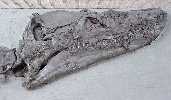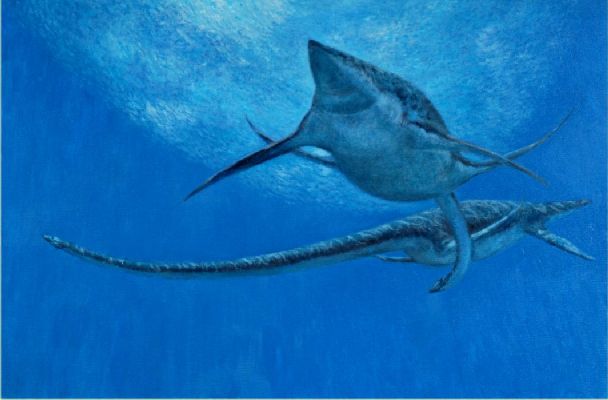 |
Something about Plesiosaurs (Elasmosaurs)
Copyright © 2001-2012 by Mike Everhart
Last updated 05/09/2012
LEFT: Two elasmosaurs cross paths
while feeding in the Western Interior Sea. Painting copyright © 2005 by Dan Varner and
may not be reproduced in any form without the express written permission of Dan Varner and
Mike Everhart. |
CHECK OUT THE KANSAS
PLESIOSAURS WEB PAGE
 |
The picture at near left is about as close as I've been to an
plesiosaur ....and I've had the good fortune to be that close to five of them so far! This
is actually the hind quarters of a large elasmosaur called Styxosaurus that we
helped the New Jersey State Museum excavate in 1991-3. The site is
located in western Logan County, Kansas, not far from the locality where the infamous 'head on the wrong end'
plesiosaur specimen was discovered in 1867 by Dr.
Theophilus Turner. That specimen (Elasmosaurus platyurus) was shipped
to E. D. Cope at the Philadelphia Academy of Natural
Sciences where it has been kept ever since. See Ben Creisler's Plesiosaur Translation and
Pronunciation Guide for more information regarding plesiosaur names and their
pronunciations. |
 |
In a letter dated Feb. 2, 1868 from Dr. Turner to his brother (Almy, 1987, p.
186), he describes the "extinct monster" that he had found several months
earlier: "... I do not recollect that I ever wrote you concerning the fossils
skeleton which I have been for a long time trying to secure. It proved to be a huge affair
and was located in an almost perpendicular bank of
slate hill which made up one side of a ravine. It was located near the bottom
and required no small amount of labor in the excavation - It is probably a reptile
of the cretatious [sic] formation. I have in my possession boxed ready for transportation
to the Philadelphia Academy of Natural Sciences something over thirty-five feet of it's
vertebrae with four inches of the anterior portion of its head with imperfect teeth:
imperfect because at the sockets - I can assure I sincerely regret this
imperfection."
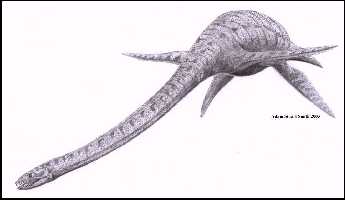 |
"There is however, enough of this to lead me to suppose that
the critter had a head little short of four feet in length. We
also secured part of one of its jaws containing teeth - There is a large amount of
bony matter contained in a very hard stone matrix, some of which retains its connection
with the backbone. Among the rest is a portion of a limb, a perfect bone eight or
ten inches in length. Which will assist in no small way toward the identification. The
whole, stone and all, weighs about eight or nine hundred pounds, on which the Academy will
have an express bill of no small proportions to pay. .." LEFT: Drawing of Elasmosaurus platyurus Cope by Adam
Stewart-Smith. Copyright © 2003 by Adam Stewart-Smith. Used with permission.
Adam Smith's The
Plesiosaur Directory |
The photograph at the top of this page shows almost all of the caudal vertebrae and one of the
rear paddles of a nearly complete Styxosaurus specimen. The paddle is
slightly over 1 meter in length (Lower side shown here).
The 'femur' is at the top left and a portion of the pelvis is in the extreme top left
corner. The large 'lump' at top center is a section of abdominal vertebrae that are
encased in a concretion. The specimen was complete......except for the skull which may
have eroded out many years previously. There were stomach contents (fish bones and scales)
and a large number of (95+) quartz and chert gastroliths,
including several that weighed about a pound. (Click here to see the paper published in
2001 on this specimen)
 |
Styxosaurus snowii, a long-necked plesiosaur found in the
Pierre Shale of western Kansas and South Dakota. |
Plesiosaurs were an important group of marine reptiles during the
Age of Dinosaurs. Nearly as old as the dinosaurs, they made their first appearance during
the Triassic and became extinct at the end of the Cretaceous. They were obviously
less fish-like in form than the ichthyosaurs, but were still very well adapted for life in
the oceans. One group of Cretaceous plesiosaurs, generally referred to as 'elasmosaurs',
had short tails and long necks. This group also includes the smaller, short-necked "Polycotylids".
Pliosaurs, like Kronosaurus
and Brachauchenius on
the other hand, generally had a short neck and a relatively large head. In both groups,
the body was broad and relatively compact, with closely set, strong ribs and well
developed gastralia (belly ribs) to protect / stiffen the abdomen.
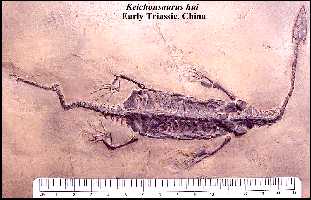 |
Paleontologists are still uncertain what the ancestors of the
first plesiosaurs looked like but it is probable that they came from small, primitive
aquatic reptiles (nothosaurs) that were very similar to the early Triassic
pachypleurosaurs found in China (Keichousaurus hui
is shown at right and left). In these animals, the tail was used to
propel the animal through the water. The limbs probably were used as paddles to some
extent, but could also still move the animal on land. The long neck and small head are
also early plesiosaur traits. |
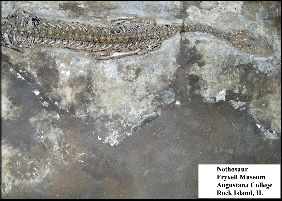 |
 |
The first nearly complete plesiosaur was discovered in the
Jurassic rocks of Lyme Regis, England by Mary Anning in the winter of 1820-21. The name Plesiosaurus
was given by the Reverend William Conybeare and means "near-reptile", a
reference to the view of the time that plesiosaurs were closer to reptiles than were the
more fish-like ichthyosaurs. (Figure at left from Owen, 1860) |
In both plesiosaurs and pliosaurs, the limbs were also very large and modified
into well developed, paddles which were the main means of propulsion. Recent studies
of plesiosaur paddles have shown that, instead of being pulled back and forth like oars on
a rowboat, they were 'flapped' up and down much like the wings of
a bird or the paddles of a marine turtle. The plesiosaur, in effect, 'flew'
through the water like a modern penguin.
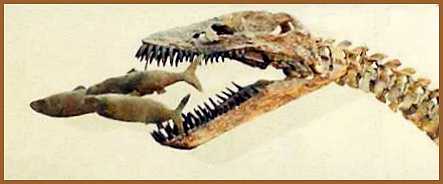 |
Plesiosaurs ate fish, small
ammonites and other invertebrates. Many specimens have gastroliths
or stomach stones in their abdomens. There is still some controversy about
whether or not they laid eggs, but evidence found in South Dakota and Kansas seems to
point toward plesiosaurs giving live birth like ichthyosaurs and mosasaurs. It is
hard to imagine a forty-foot plesiosaur struggling up on a beach to lay eggs like a sea
turtle. Besides having limbs that were unsuitable for travel on land, there are
several good physiological reasons (such as over-heating, and not being able to breathe)
why egg laying would probably have not been possible in plesiosaurs.. |
 |
UNSM 1195: The University of Nebraska State Museum has another
partial plesiosaur specimen, collected from the Lincoln Member of the Greenhorn Formation,
Ellsworth County, Kansas by George Sternberg and M. V. Walker, and sold to the
University of Nebraska about 1935. The specimen consists of the pectoral
girdle, limb elements (two complete paddles), vertebrae and numerous gastroliths.
The specimen was found by Joe Purzer, a petroleum geologist from Bartlesville, OK. |
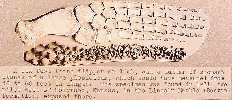 |
This photograph was taken before the specimen was sent from Kansas
to Nebraska and shows the gastroliths lying alongside one of the paddles. According
the the documentation that went with the specimen, the remains were nearly complete,
lacking some cervical vertebrae and the skull. |
 |
This is a picture of the more than 240 gastroliths (stomach
stones) found associated with the above plesiosaur remains by George Sternberg. The
largest stone measured 79 x 57 x 28 mm and the total weight of the gastroliths was 2.2 kg.
One interesting thing about the gastroliths was that they appear to have originated
from several distinct locations (Note the tan colored stones on the right side of the
picture). |
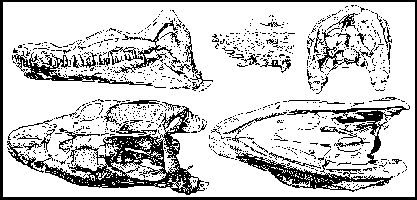 |
The skull of the type specimen of Alzadasaurus columbiensis
(now Callawayasaurus columbiensis sensu Carpenter, 1999), a plesiosaur from from
Columbia, South America. The skull is 35 cm (14 inches) in length. Adapted from "A
New Species of Elasmosaur from the Aptian of Columbia and a Review of the Cretaceous
Plesiosaurs", S. P. Welles, 1962. |
 |
The skull of Muraenosaurus (about 14
inches), as published in Vertebrate Paleontology, Alfred S. Romer, The University of
Chicago Press, 1967.
|
Shown below are several drawings of elasmosaur skulls from the Ph.D. thesis of
Ken Carpenter (Denver Museum of Nature and Science) ...... "Comparative Cranial
Anatomy of Two North American Plesiosaurs (Reptilia: Sauropterygia), and a Review of Some
North American Elasmosaurs" These figures were also published recently in Ancient
Marine Reptiles, edited by Jack M. Callaway and Elizabeth L. Nichols (Academic Press,
1997), Chapter 7, "Comparative Cranial Anatomy of Two North American Cretaceous
Plesiosaurs", by Kenneth Carpenter. Copyright by and used with permission of
Kenneth Carpenter.
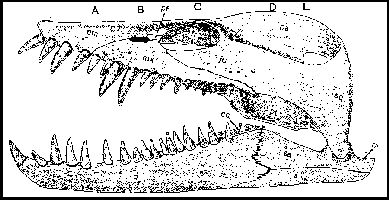 |
Skull of Libonectes morgani (SMU-SMP 69120) in left
lateral view. Copyright by and used with permission of Kenneth Carpenter. |
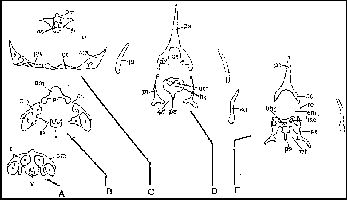 |
Skull of Libonectes morgani (SMU-SMP 69120) with lateral
reconstructions of cross sections from CAT scans. Copyright by and used with permission of
Kenneth Carpenter. |
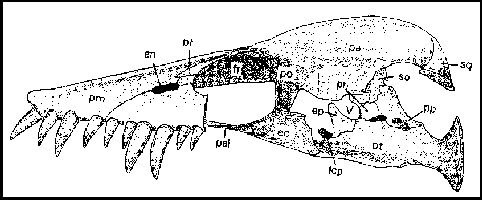 |
Skull of Libonectes morgani (SMU-SMP 69120) with
postorbital section of the skull removed. Copyright by and used with permission of Kenneth
Carpenter. |
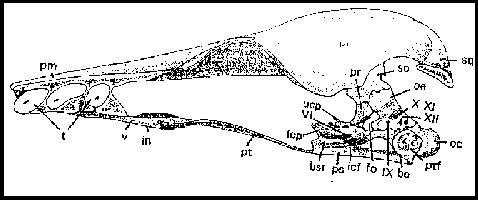 |
Skull of Libonectes morgani (SMU-SMP 69120) with side of
skull removed showing braincase. Copyright by and used with permission of Kenneth
Carpenter. |
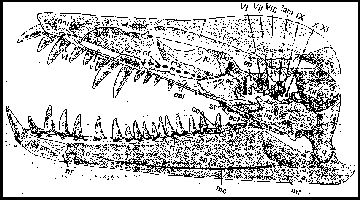 |
Skull of Libonectes morgani (SMU-SMP 69120) in sagittal
section showing interior of braincase and internal view of right side of skull. Copyright
by and used with permission of Kenneth Carpenter. |
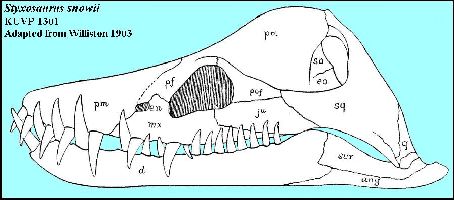 |
LEFT: Although a figure of the skull of "Cimoliasaurus"
(Styxosaurus) snowii (KUVP 1301) in left lateral view was first published by Williston (1890b), he later
published this labeled version in 1903. This was the upper side of the skull as found.
Williston (1890b) noted, "The right side of the skull
is not at all disturbed, save the effects of compression and the chemical action upon the
teeth. The upper side, however, though the teeth are in perfect preservation, and the
relative positions of the mandible and maxilla are unchanged, has been crowded up about 3
inches, nearly obliterating the orbit. As prepared, however, the left orbit does preserve
"13 sclerotic plates." Cimoliasaurus snowii (Williston)
was renamed Styxosaurus by S. P. Welles in 1943. Styx is the mythical
river in Hades. The type specimen was collected by Judge E.P. West near Hell Creek in
Logan County, Kansas, hence the name "Hell Creek lizard."
Ken Carpenter's figure of
the right side of the skull is here |
 |
The skull of Styxosaurus snowii (KUVP
1301) at the University of Kansas Museum of Natural History mounted in right lateral view
with 28 articulated cervical vertebrae. Click on the thumbnails for larger views of
this skull.
|
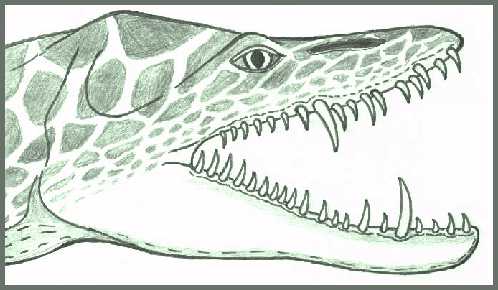 |
A 'flesh on the bones' reconstruction of the
head of Styxosaurus snowii, © Mike Everhart, 1999. (The
official mascot of the 1999 Cincinnati Museum Plesiosaur Dig) |
 |
The skull of a mounted specimen of Styxosaurus snowii (SDSMT
451) at the Museum of Geology, South Dakota School of Mines and Technology. To see
the entire specimen, CLICK HERE |
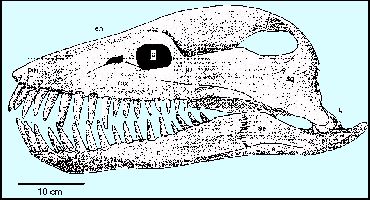 |
LEFT: A reconstruction of the skull of Thalassomedon
haningtoni. Copyright by and used with permission of Kenneth Carpenter. RIGHT:
A model of the skull of Thalassomedon haningtoni from DMNH 1588 at the Tate
Geological Museum, Casper, WY. For pictures of the original skull, another cast, and the
mounted skeleton, visit the Denver Museum of Nature and Science
webpage. |
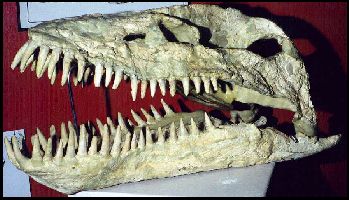 |
 |
LEFT: A 1950s vintage picture of the Thalassomedon
haningtoni (DMNH 1588) specimen in the Denver Museum (Modified from a photo by Robert
R. Wright) A second specimen of Thalassomedon haningtoni is
in the collection of the University of Nebraska State Museum. |

Cryptoclidus
, a long necked, Jurassic plesiosaur from a reconstruction based on the work of Dr.
David Brown as published in The Illustrated Encyclopedia of Dinosaurs, Salamander Books
LTD, 1985.
Plesiosaurs (above and below) also had a series of dermal bones, called
gastralia, across their lower body between the pectoral and pelvic girdles. These
bones probably served to stiffen the body of the animal in order to make swimming (or
underwater flight) more efficient.
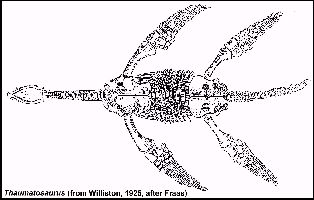 |
LEFT: A ventral view of a beautiful specimen of the Jurassic plesiosaur
Thaumatosaurus von Meyer 1841, showing the relationship between the
gastralia and the pectoral and pelvic girdles. This specimen was more
recently attributed to Rhomaleosaurus victor. The specimen
was damaged by fire in WW II. According to Markus Moser (Pers.
comm, 2004), the specimen was repaired by Norbert Adorf in 1975 who spent about 8 months
on the project using most of the original bones and a cast of the original (the
original preparation took 8 months in 1908). The
specimen (SMNS 12478) is currently on exhibit. Photo by Markus Moser, 2004. Original drawing by Eberhard Fraas: Fraas E. 1910.
Plesiosaurier aus dem oberen Lias von Holzmaden. Palaeontographica 57:105-140,
11 figs., pls. VI-X. (Scanned from Williston, 1925) |
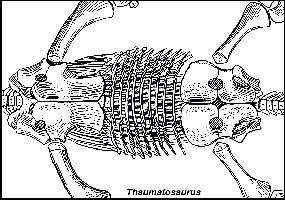 |
LEFT: Thaumatosaurus victor - A close up
of the "belly of the beast" showing the interlocking gastralia that covered the
middle portion of the body. The specimen does contain some gastroliths (pers. comm.,
Oliver Wings, 2004). The specimen
(SMNS 12478) is currently on exhibit in the Staatliches Museum fuer Naturkunde
Stuttgart, Museum am Loewentor, Rosenstein 1, 70191 Stuttgart, Germany. (Photo by Markus
Moser, 2004)
The name Thaumatosaurus translates roughly to "wonder
lizard." See Ben Creisler's
Translation and Pronunciation Guide for more information on plesiosaurs. |
More information here on Jurassic plesiosaurs: Adam Smith's The
Plesiosaur Directory
PLESIOSAUR LIMBS:
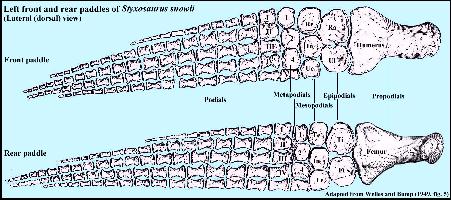 |
Although plesiosaurs evolved from terrestrial reptiles with four
legs, the limbs were highly modified into paddles, and lost most of the mobility of the
elbow / knee, wrist / ankle and fingers / toes. The bones of the wrist became specialized
to the point that they have had to be given different names (no longer carpals or
tarsals). LEFT: A lateral (dorsal) view of the left front and rear
limbs of Styxosaurus snowii (SDSMT 451) as adapted from
Welles and Bump (1949, pl. 5) Abbreviations: Ra = Radius; Ul = Ulna; Ti =
Tibia; Fi = Fibula; Re = Radiale; In = Intermedium; Ue = Ulnare; Te = Tibiale; Fe =
Fibulare.
PLESIOSAUR SWIMMING
--- Animations on the Plesiosauria website by Adam Stuart Smith |
PLESIOSAUR LIMB MUSCLES
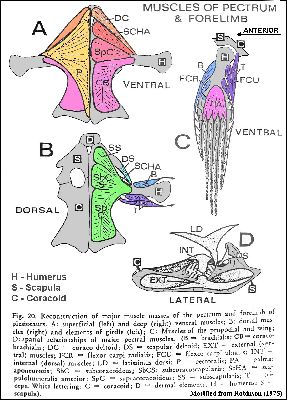 |
LEFT and RIGHT: Figures 20 and 22 from Robinson (1975) showing her
interpretation of the muscle attachments for the front and hind limbs of plesiosaurs. She
observed muscle attachment scars on the plesiosaur bones and compared them with the
bones/muscles of modern reptiles. Muscles pretty much stay the same throughout the
evolution of the tetrapods (and plesiosaurs are descended from terrestrial tetrapods)...
The muscles have different sizes and shapes, but they are usually the same muscles.
Note in Fig. 20 that the triceps (T - "three headed muscle") attaches to the
plesiosaur humerus in twp places and once on the coracoid just like it attaches to your
humerus and scapula. Each muscle has an "origin" where it is attached to an
immovable bone and an "insertion" where it attaches to the bone that it moves..
Your triceps is "inserted" on or attached to the ulna and is responsible for
straightening your lower arm. It is opposed by the biceps that flexes the lower arm.
In plesiosaur paddles the "elbow" (knee) and the "wrist" (ankle) are
relatively inflexible joints but the same muscles are attached.... and probably served to
change the angle the limb for steering or climbing/diving while the animal swam.
Plesiosaurs would have had large sheets of muscle on the ventral side of the scapula and
coracoid, and also on the pelvis (pubis and ischium) to provide power for the downstroke
of the paddles. Smaller muscles on the dorsal side of those same large bones would have
moved the paddles upward. |
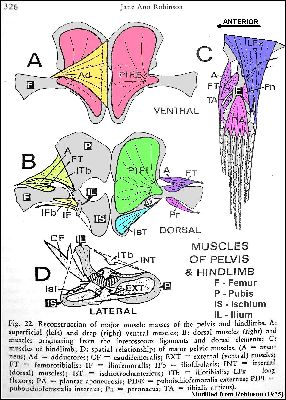 |
Unfortunately, plesiosaurs are few and far between in the Niobrara (Smoky Hill
Chalk and Fort Hays Limestone). According to a survey by Russell (1988), plesiosaurs make
up only about one percent (1%) of the vertebrate remains in museum collections from the
Smoky Hill Chalk. What we do find most often in the chalk are the scattered pieces
of plesiosaur carcasses that had been torn apart during scavenging by other predators (See Sternberg, 1922 for a report of a plesiosaur as stomach contents
of a Tylosaurus) The bones are unusually solid and heavy, but some still bear
the marks of the teeth that severed them from the plesiosaur's body. In Kansas,
plesiosaurs are more common in the underlying Kiowa Shale (Early Cretaceous), Greenhorn
Limestone and Carlile Shale (Late Cretaceous), and in the overlying Pierre Shale (Late
Cretaceous).
In 1895, Charles Sternberg came across the remains of a huge elasmosaur that had
been uncovered and nearly destroyed by a farmer during an excavation for a building on his
farm. In his 1917 book, Sternberg described what he saw; “I told Maud of a complete
skeleton that had once been found by a farmer in the Kansas Chalk of Butte Creek, Logan
County. He started to excavate a place for a stable, when he uncovered some huge
vertebrae, and ribs over five feet long. He supposed they were elephant bones, and as they
were broken, he thought they could not be saved, and so he dug up the bones with the
chalk. They were dumped into a cow yard and beaten to powder under their feet, and could
never be restored. I grieved much over the loss to science of that splendid specimen that
has never been duplicated.
Dr. S. W. Williston, the oldest living American vertebrate paleontologist, described
the few bones I was able to save from the general wreck. He did me the honor of naming it
after me.” (See also Williston, 1906)
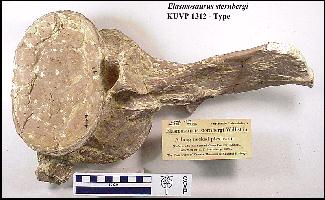 |
LEFT: KUVP 1312 - One of the two remaining vertebrae of what may have
been a fairly complete and quite large elasmosaur (Elasmosaurus sternbergi)
collected by Charles Sternberg in 1895 from along Butte Creek in Logan County. Until
recently, the specimen was thought to be from Gove County (see tag). The
centrum is 16.5 cm wide and 14 cm tall. |
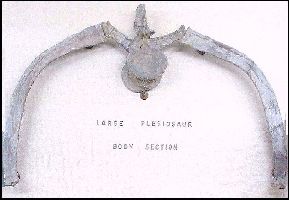 |
LEFT:The exhibit at the University of Kansas Museum of Natural
History includes a cross section of a large elasmosaur, (numbered as KUVP 432, but
actually part of KUVP 1312 "Elasmosaurus sternbergi"- above)
including a dorsal vertebra and a single rib (the second rib is a cast). The
specimen is about 4 feet across. The specimen was uncovered during the construction of a
farm building in Logan County, Kansas, and was mostly destroyed. Charles
Sternberg was able to salvage a few of the bones and wrote about the discovery in his
book: "Hunting Dinosaurs in the Badlands of the Red Deer River, Alberta, Canada"
(1917). |
 |
An 'as found' view of a lonely plesiosaur propodial eroding out
on the surface of the Smoky Hill chalk in Gove County, Kansas. From the Squalicorax
bite marks that were found on the bone and the fact that no other plesiosaur material was
found in the vicinity, it seems apparent that this readily 'detachable' piece was torn
away by scavenging sharks before being dropped. (Everhart,
2003) |
 |
Another 'detached' plesiosaur podial (length about 24 inches).
This one was discovered by George Sternberg and is on exhibit in the Fick Fossil and
History Museum in Oakley, Kansas. The deep bite marks on the upper portion of the bone
attest to the violence of the scavenging and the size of the scavenger (a large late Cretaceous shark, Cretoxyrhina mantelli).
(For more information, see Everhart, 2005) |
 |
This specimen represents the only plesiosaur skull remains that
we have ever found in the chalk (upper Coniacian - about 86 mya). The bone fragments were
scattered over a large area and are mostly unrecognizable. They remained unidentified
until we showed them to J.D. Stewart of the Los Angeles County Museum of Natural History.
Ken Carpenter identified most of the skull for me in 2002. The two semi-circular shapes
are the hinge points for the lower jaw of the plesiosaur, indicating another possible
'detachable' part that was carried off by a shark. (Everhart,
2003) |
 |
This is the hip joint of a very large Dolichorhynchops
osborni pliosaur from the lower portion of the Pierre Shale in Logan County. My
wife, Pam, found this specimen in 1992 while the rest of us were working on the New Jersey
State Museum Alzadasaurus. She had asked our friend, Pete Bussen, "What does a plesiosaur fossil look
like in the shale?" They walked up the hill for a look, and within ten minutes,
she picked up a small paddle bone, and found her first plesiosaur coming out of a
concretion. Scale is 6 inches. Larger, more recent
picture HERE |
 |
An upper limb bone or propodial of a young plesiosaur (species
indeterminate) found in the Bluffport Marl Member of the Demopolis Formation (Campanian)
in Clay County, Mississippi by Lynn Harrell, Jr.. Length is about 8 inches / 20.5
cm. In juvenile plesiosaurs, the limb bones were growing rapidly and the joints were
composed primarily of cartilage. Note the lack of articular surfaces on the ends of
this bone compared to some of the adult limb bones shown above. |
 |
The Tate Museum in Casper, Wyoming, has a nearly complete
paddle from a what must have been a huge Jurassic pliosaur (Megalneusaurus) that may have been the largest marine
predator that ever lived. Found in the 1800s in Wyoming, this pliosaur may have been
40 feet long and weighed about 10 tons. According to Bill Wahl, the type locality has been
re-discovered and additional remains are being recovered. |
 |
 |
An paleo-life artist's reconstruction of a scene showing an
elasmosaur hunting for dinner in the Bearpaw Sea, an extension of the Western Interior
Seaway during the late Cretaceous in what is now western Canada. Painting by Vladimir Krb,
courtesy of the Royal Tyrrell Museum of
Palaeontology. |
KANSAS PLESIOSAURS
Click here for an article about
elasmosaurs in Prehistoric Times magazine (#53, April 2002).
The New Jersey State Museum Dig - 1991
"We Dug Plesiosaurs" - with
the Cincinnati Museum in 1998
The 1999 Cincinnati Museum Plesiosaur
Dig
You mean they ate rocks?
Plesiosaurs and gastroliths
Plesiosaur
stomach contents and gastroliths
A page about Pliosaurs (short necked
plesiosaurs)
The Styxosaurus snowii elasmosaur at the
South Dakota School of Mines
Plesiosaur References: A listing of
publications related to plesiosaurs
A list of references in my library about
mosasaurs and plesiosaurs
Ray Ancog's
Plesiosaur FAQ Page (Frequently Asked Questions)
Plesiosauria
Translation and Pronunciation Guide
Barry
Kazmer's Plesiosaur Paleontology
Richard
Forrest's listing of plesiosaur specimens and literature
Richard
Forrest's 5 Questions about Plesiosaurs (serious stuff!)
The Denver Museum
elasmosaur (Thalassomedon haningtoni)
The longest neck in the
ocean" (University of Nebraska State Museum elasmosaurs)
A primer on the anatomy
of the plesiosaur skull.
Adam
Smith's The Plesiosaur Directory
SELECTED REFERENCES:
Almy, Kenneth J. 1987. Thof’s dragon and the letters of Capt.
Theophilus Turner, M.D., U.S. Army, Kansas History Magazine, 10(3):170-200.
(Background on the discovery of Elasmosaurus platyurus, Cope’s "head on
the wrong end" plesiosaur - historical)
Brown, B. 1904. Stomach stones and the food of
plesiosaurs. Science, 20(501):184-185. (Gastroliths mixed with stomach contents in
plesiosaurs)
Carpenter, K. 1994. Comparative cranial anatomy of two North American
plesiosaurs (Reptilia: Sauropterygia) and a review of some North American elasmosaurs,
unpublished draft.
Carpenter, K. 1994., A review of some short-necked plesiosaurs from the
Cretaceous of North America, unpublished draft.
Carpenter, K. 1996. A review of short-necked plesiosaurs from the
Cretaceous of the Western Interior, North America, Neues Jahrbuch für Geologie und
Paläeontologie Abhandlungen, (Stuttgart) 201(2):259-287.
Carpenter, K. 1997. Comparative cranial anatomy of two North American
Cretaceous plesiosaurs, In Calloway J. M. and Nicholls, E. L., eds, Ancient
Marine Reptiles, Academic Press, pp. 191-216
Carpenter, Kenneth. 1999. Revision of North American Elasmosaurs from the
Cretaceous of the Western Interior, Paludicola, 2(2):148-173.
Cicimurri, D. J. and M. J. Everhart. 2001. An elasmosaur with stomach contents and
gastroliths from the Pierre Shale (late Cretaceous) of
Kansas. Kansas Acad. Sci. Trans 104(3-4):129-143.
Cope, E. D. 1868. Remarks on a new enaliosaurian, Elasmosaurus
platyurus. Proc. Acad. Nat. Sci. Phil., 20:92-93. (for meeting of March 24, 1868)
Cope, E. D. 1868. (on new species of extinct reptiles). Proc. Acad. Nat. Sci.
Phil., 20:181. (for meeting of July 14, 1868.
Cope, E. D. 1868. On some Cretaceous reptilia. Proc. Acad. Nat. Sci. Phil.
20:233-242. (for meeting of Oct. 27, 1868)
Cope, E. D. 1868. (A resolution thanking Dr. Theophilus
Turner for his donation of the skeleton of Elasmosaurus platyurus). 20:314
.
Cope, E. D. 1868. On the genus Laelaps. Amer. Jour. Sci. ser. 2,
46(138):415-417.
Cope, E. D. 1870. On Elasmosaurus platyurus
Cope. Amer. Jour. Sci., ser. 2, 50(148):140-141.
Cope, E. D. 1870. Additional note on Elasmosaurus.
Amer. Jour. Sci., ser. 2, 50(149):268-269.
Cope, E. D. 1870. Extinct Batrachia, Reptilia and Aves of North
America. Transactions of the American Philosophical Society. New Series 14:1-253.
Darby, D. G. and R. W. Ojakangas, 1980. Gastroliths from an Upper
Cretaceous plesiosaur, Journal of Paleontology, 54(3):548-556.
Everhart, M. J. 2000. Gastroliths
associated with plesiosaur remains in the Sharon Springs Member of the Pierre Shale (late
Cretaceous), Western Kansas. Kansas Acad. Sci. Trans. 103(1-2):58-69.
Everhart, M. J. 2002. Where the
elasmosaurs roam...... Prehistoric Times. 53:24-27.
Everhart, M. J. 2003 First records
of plesiosaur remains in the lower Smoky Hill Chalk Member (Upper Coniacian) of the
Niobrara Formation in western Kansas. Kansas Academy of Science, Transactions
106(3-4):139-148.
Everhart, M. J. 2004. Conchoidal fractures preserved on elasmosaur
gastroliths are evidence of use in processing food. Journal of Vertebrate Paleontology 24
(Supplement to 3): 56A.
Everhart, M. J. 2005. Bite marks on an elasmosaur (Sauropterygia;
Plesiosauria) paddle from the Niobrara Chalk (Upper Cretaceous) as probable evidence of
feeding by the lamniform shark, Cretoxyrhina mantelli. PalArch, Vertebrate paleontology
2(2): 14-24.
Everhart, M. J. 2005. Oceans of Kansas - A Natural History of the Western
Interior Sea. Indiana University Press, 320 pp.
Everhart, M.J. 2005. Probable plesiosaur gastroliths from the basal Kiowa Shale (Early
Cretaceous) of Kiowa County, Kansas. Kansas Academy of Science, Transactions 108 (3/4):
109-115.
Everhart, M. J. 2005. Elasmosaurid remains from the Pierre Shale (Upper Cretaceous) of
western Kansas. Possible missing elements of the type specimen of Elasmosaurus
platyurus Cope 1868? PalArch 4(3): 19-32.
Everhart, M. J. 2006. The occurrence of elasmosaurids (Reptilia: Plesiosauria)
in the Niobrara Chalk of Western Kansas. Paludicola 5(4):170-183.
Everhart, M.J. 2009. Probable plesiosaur remains from the Blue Hill Shale
(Carlile Formation; Middle Turonian) of north central Kansas. Kansas Academy of Science,
Transactions 112(3/4):215-221.
Hawkins, T. 1834. Memoirs of
ichthyosauri and plesiosauri, extinct monsters of the ancient Earth. Roy. fol.,
London. ix + 58 pp., frontisp., 28 pls.
Henderson,
D.M. 2006. Floating point: a computational study of buoyancy, equilibrium, and gastroliths
in plesiosaurs. Lethaia 39:227-244.
Kubo, T., Mitchell, M.T. and Henderson, D.M.
2012. Albertonectes vanderveldei, a new elasmosaur (Reptilia,
Sauropterygia) from the Upper Cretaceous of Alberta. Journal of Vertebrate
Paleontology 32(3):557-572.
Leidy, J. 1870. (Remarks on Elasmosaurus platyurus).
Proc. Acad. Nat. Sci. Phil. 22:9-10. (for meeting of March 8, 1870)
Leidy, J. 1870. On the Elasmosaurus platyurus
of Cope. Amer. Jour. Sci. ser. 2, 49(147):392.
Lucas, F.A. 1903. A new plesiosaur.
Smithsonian Miscellaneous Collections 45:96, pl. XXVIII (Quarterly Issue Vol. 1), 1457.
Martin, J.E. and Kennedy, L.E. 1988. A plesiosaur from the late
Cretaceous (Campanian) Pierre Shale of South Dakota: A Preliminary Report, Proc. S.D.
Acad. Sci., 67:76-79
O'Keefe, F.R. 2008. Cranial anatomy and taxonomy of Dolichorhynchops
bonneri new combination, a polycotylid plesiosaur from the Pierre Shale of Wyoming
and South Dakota. Journal of Vertebrate Paleontology 28(3): 664-676.
O’Keefe, F.R. and Chiappe, L.M.
2011. Viviparity and K-selected life history in a Mesozoic marine plesiosaur
(Reptilia, Sauropterygia). Science 333(6044):870-873.
Owen, R. 1860. Palaeontology, or a systematic summary of extinct animals and
their geological relations. Adam and Charles Black, Edinburgh, xv +420 p. 142 text figs.
(1st edition).
Riggs, Elmer S. 1939. A specimen of Elasmosaurus serpentinus, Field
Museum of Natural History, Geology, 6:385-391.
Robinson, J. A. 1975. The locomotion of plesiosaurs. Neues Jahrbuch für
Geologie und Paläeontologie Abhandlungen, (Stuttgart) 149, 3:286-332.
Russell, D. A. 1988. A check list of North American marine cretaceous
vertebrates Including fresh water fishes, Occasional Paper of the Tyrrell Museum of
Palaeontology, (4):57.
Sato, T. and Tanabe, K. 1998. Cretaceous
plesiosaurs ate ammonites, Nature, 394:629-630.
Schmeisser,
R.L. and Gillette, D.D. 2009. Unusual occurrence
of gastroliths in a polycotylid plesiosaur from the Upper Cretaceous Tropic Shale,
southern Utah. PALAIOS 2009 24: 453-459.
Schumacher, B. A. and M. J. Everhart. 2005. A stratigraphic
and taxonomic review of plesiosaurs from the old “Fort Benton Group” of central
Kansas: A new assessment of old records. Paludicola 5(2):33-54.
Shimada, K., Tsuihiji,
T., Sato, T. and Hasegawa, Y. 2010. A remarkable case of a shark-bitten
elasmosaurid plesiosaur. Journal of Vertebrate Paleontology 30(2):592-597.
Sternberg, C. H. 1917 (1932). Hunting Dinosaurs in the Badlands
of the Red Deer River, Alberta, Canada. Published by the author, San Diego, Calif.,
261 pp. (Reference to elasmosaurs, incl. note on p. 166 about the discovery of KUVP 1312,
the type specimen of Elasmosaurus sternbergi)
Storrs, G. W. 1981. A review of occurrences of the Plesiosauria (Reptilia:
Sauropterygia) in Texas with Description of New Material, Masters Thesis, The University
of Texas at Austin, 226 pages.
Storrs, G. W., 1984. Elasmosaurus platyurus and a page from the
Cope-Marsh war. Discovery 17(2):25-27.
Storrs, G. W. 1997. Morphological and taxonomic clarification of the
genus Plesiosaurus, pp. 145-190, In Calloway, J. M. and Nicholls, E. L.,
eds, Ancient Marine Reptiles, Academic Press.
Storrs, G. W. 1999. An examination of Plesiosauria (Diapsida: Sauropterygia)
from the Niobrara Chalk (upper Cretaceous) of central North America, The University of
Kansas Paleontological Contributions, (N. S.), No. 11, 15 pp.
Taylor, M. A. 1993. Stomach stones for feeding or buoyancy? The occurrence and
function of gastroliths in marine tetrapods, Phil. Trans. R. Soc. London. B 341:163-175.
Taylor, M. A. 1994. Stone, bone or blubber? Buoyancy control strategies in
aquatic tetrapods, pp.151-161, In Maddock, L., Bone, Q., and Rayner, J. M. V.
(ed.), Mechanics and Physiology of Animal Swimming, Cambridge University Press,
Thompson, W. A.,
Martin, J. E. and Reguero, M. 2007. Comparison of
gastroliths within plesiosaurs (Elasmosauridae) from the Late Cretaceous marine deposits
of Vega Island, Antarctic Peninsula, and the Missouri River area, South Dakota. Pages
147-153 in Martin, J. E. and Parris D. C. (eds.), The
Geology and Paleontology of the Late Cretaceous Marine Deposits of the Dakotas. Geological
Society of America, Special Paper 427.
Welles, S. P. 1943. Elasmosaurid plesiosaurs with a description of the new
material from California and Colorado. University of California Memoirs 13:125-254.
figs.1-37., pls.12-29.
Welles, S. P. 1949, A new elasmosaur from the Eagle Ford Shale of Texas,
Fondren Science Series, Southern Methodist University, 1:1-28
Welles, S. P. 1952. A review of the North American Cretaceous elasmosaurs.
University of California Publications in Geological Sciences. 29:46-144. figs. 1-25.
Welles, S. P. and James Bump. 1949. Alzadasaurus pembertoni, a new
elasmosaur from the Upper Cretaceous of South Dakota. Journal of Paleontology,
23(5):521-535.
Williston, S. W. 1890a. Structure of
the plesiosaurian skull. Science 16(407):290. (Discusses features of the skull and
turtles)
Williston, S. W. 1890b. A new plesiosaur from the Niobrara Cretaceous of Kansas.
Kansas
Academy Science, Transactions 7:174-178, with 2 fig.
Williston, S. W. 1893. An interesting food habit of
the plesiosaurs. Trans. Kansas Acad. Sci., 13:121-122, 1 plate. (Gastroliths)
Williston, S. W. 1903. North American Plesiosaurs. Field Columbian Museum, Pub.
73, Geological Series, 2(1):1-79, 29 plates.
Williston, S. W. 1904. The stomach stones of the
plesiosaurs. Science (new series) 22:565.
Williston, S. W., 1906. North American Plesiosaurs: Elasmosaurus,
Cimoliasaurus, and Polycotylus. American Journal of Science, 4(21):221-236.
Williston, S. W. 1907. The skull of Brachauchenius, with special
observations on the relationships of the plesiosaurs. United States National Museum
Proceedings 32:477-489. pls. 34-37.
Williston, S. W. 1908. North American Plesiosaurs: Trinacromerum.
Journal of Geology 16:715-735. figs. 1-15.
Williston, S. W. 1914. Water Reptiles of the Past and Present. Chicago Univ.
Press. 251 pp.

BACK TO INDEX






















